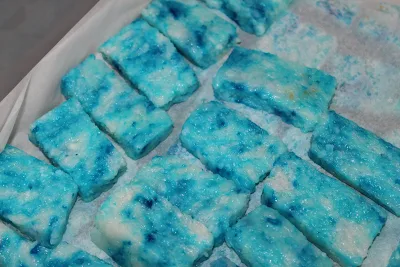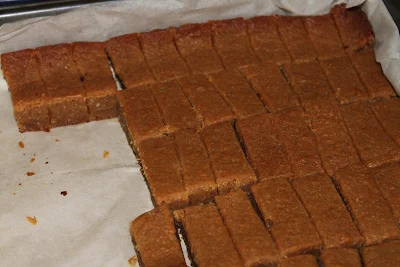This glutinous rice based dessert (above), with the fanciful name of pulut tai tai, is dyed with the natural colours of the butterfly pea flower petals (bunga telang), to produce an overall pleasing marine blue effect, before applying an egg-based coconut flavoured jam, called kaya, to spread over the savoury pieces. Also refer to image below, foreground.
The diverse and delectable variety of kueh from the Peranakan or Straits Chinese tradition.
With demands in attention to detail, emphasis on texture, presentation and making use of natural ingredients from home and garden, this cuisine requires lots of experience, practice and heart to produce palate sensations that demonstrate personal rigour, patience and art. Families from Malacca, Singapore, Penang, Medan and Phuket now have members spread out across a diaspora across the main Anglo-Celtic nations of the United Kingdom, New Zealand, Australia, the United States of America and Canada, which now may serve as the next possible vehicles to continue this cuisine.
The seri muka, or literally smooth face, an afternoon dessert that is cut to bite -sized slices when served. The resulting slices have a white underlay beneath the thinner green top, and reminds one of flavours wrung from the pandanus leaves common in the equatorial belt. The image above was taken from the kitchen of Susan Chan in Carlingford, Sydney.
Tapioca-based savoury cakes, or the chu chu kueh, is best relished with a crunchy top over a moist body, and best complimented with Chinese tea. The above image shows the chu chu kueh courtesy from the kitchen of Susan Chan in Carlingford, Sydney.
Influenced heavily by the Malay denizens of South -east Asia, and rooted steeply in Chinese and Indian immigrant traditions, this cuisine covers all stages of the meal cycle in a home, from breakfast to dinner. The nasi lemak of Straits Chinese inspiration is modified from its Malay cousins. Although the coconut milk flavoured white fluffy rice continues to be the foundation of this dish, the Straits Chinese chose a lighter approach to accompany the rice - instead of curries, we now have lightly toasted peanuts, fresh cuts of cucumber, crunchy anchovies, hard boiled eggs, aromatic fried pieces of crispy fish and the compulsory dash of chili and lime juice enhanced condiment called the sambal.
The kow chan kueh (above) or nine-layered cake, is essentially made of rice flour, and topped off with pink and orange-red colouring, lovingly set with coconut milk and flavoured with knotted pandan leaves. This cake brings particularly poignant memories to me of growing up and living on Penang Island.
The yogurt cake (above) may look on first impressions to be a cousin of the jelly cake (below) , but requires ingredients of instant coffee and cocoa.












No comments:
Post a Comment